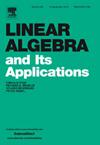Minimal error momentum Bregman-Kaczmarz
IF 1
3区 数学
Q1 MATHEMATICS
引用次数: 0
Abstract
The Bregman-Kaczmarz method is an iterative method which can solve strongly convex problems with linear constraints and uses only one or a selected number of rows of the system matrix in each iteration, thereby making it amenable for large-scale systems. To speed up convergence, we investigate acceleration by heavy ball momentum in the so-called dual update. Heavy ball acceleration of the Kaczmarz method with constant parameters has turned out to be difficult to analyze, in particular no accelerated convergence for the -error of the iterates has been proven to the best of our knowledge. Here we propose a way to adaptively choose the momentum parameter by a minimal-error principle similar to a recently proposed method for the standard randomized Kaczmarz method. The momentum parameter can be chosen to exactly minimize the error in the next iterate or to minimize a relaxed version of the minimal error principle. The former choice leads to a theoretically optimal step while the latter is cheaper to compute. We prove improved convergence results compared to the non-accelerated method. Numerical experiments show that the proposed methods can accelerate convergence in practice, also for matrices which arise from applications such as computational tomography.
求助全文
约1分钟内获得全文
求助全文
来源期刊
CiteScore
2.20
自引率
9.10%
发文量
333
审稿时长
13.8 months
期刊介绍:
Linear Algebra and its Applications publishes articles that contribute new information or new insights to matrix theory and finite dimensional linear algebra in their algebraic, arithmetic, combinatorial, geometric, or numerical aspects. It also publishes articles that give significant applications of matrix theory or linear algebra to other branches of mathematics and to other sciences. Articles that provide new information or perspectives on the historical development of matrix theory and linear algebra are also welcome. Expository articles which can serve as an introduction to a subject for workers in related areas and which bring one to the frontiers of research are encouraged. Reviews of books are published occasionally as are conference reports that provide an historical record of major meetings on matrix theory and linear algebra.

 求助内容:
求助内容: 应助结果提醒方式:
应助结果提醒方式:


